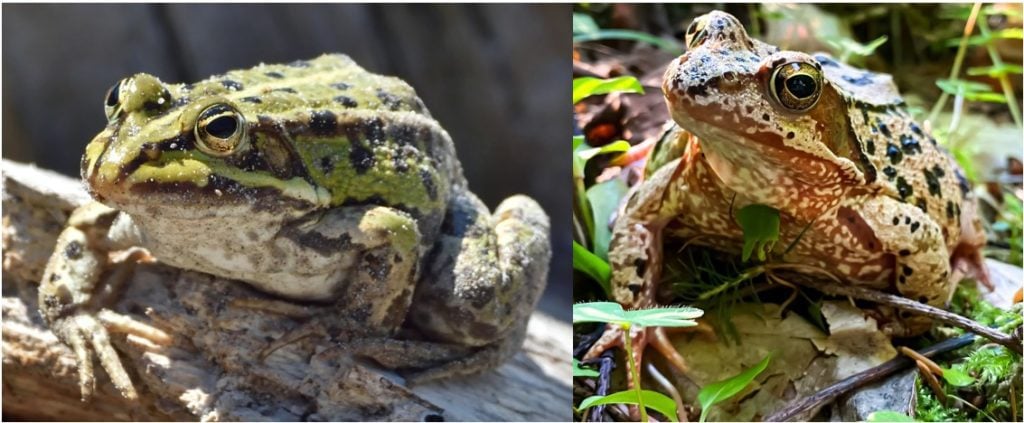4 Types of FROGS Found in Croatia! (w/Pics)
Do you want to learn about the different frogs in Croatia?

If so, you’ve come to the right place! In the article below, I have listed the frogs you can expect to see. For each species, you’ll find out how to identify that frog correctly, along with pictures, interesting facts, and RANGE MAPS!
4 types of frogs that live in Croatia:
#1. Common Tree Frog
- Hyla arborea

Identifying Characteristics:
- Adults are about 5 cm long.
- This species has very long, thin legs. Its toes are long with little webbing, and its horizontal pupils are set in golden brown eyes.
- The most typical coloring is a bright grassy green, but some individuals are brownish or gray.
The Common Tree Frog has an interesting talent; it’s a bit of a meteorologist! Believe it or not, these bright green frogs were once used to determine if it was going to rain. They often croak loudly when storms draw near because they can sense the change in air pressure.
There are only a few species of tree frog in Croatia.
Unfortunately, it can be hard to tell them apart because they all look very similar, but the Common Tree Frog is the most widespread species.
You can identify it by its bright green coloring or listen for its metallic, high-pitched croaks. This little frog is so loud it can be heard from as far away as a kilometer or more!

#2. Common Frog
- Rana temporaria

Identifying Characteristics:
- Adults grow up to 11 cm long.
- They have a short, blunt snout and partially webbed feet.
- Their coloring varies, from nearly black to pale brown, sometimes red or yellowish. The most typical markings are a white upper lip and a dark patch behind the eye.
The Common Frog is the most widespread frog in Croatia.
It lives in nearly every habitat with stagnant water, including ponds, ditches, flooded meadows, and swamps. So if you have a pond in your garden, this species is most likely using it.
Common Frogs breed explosively, meaning that hundreds of these frogs gather together and breed simultaneously. As a result, it’s not uncommon to see the bottom of entire ponds covered in frog eggs during the breeding season.
Their unusual breeding strategy means young frogs emerge in unbelievable numbers during late summer. However, some late-hatching tadpoles hibernate over winter and emerge the following spring instead.
#3. Agile Frog
- Rana dalmatina

Identifying Characteristics:
- Adults are 8 cm long.
- This species has a slender body and long legs.
- Coloring is light brown above, with pale cream to white on the belly. The legs are banded with dark brown or black, and they have a black patch behind the eye.
The Agile Frog is one species that has EARNED its common name. This large, light-colored frog can leap incredible distances when disturbed. It’s known to cover up to two meters in a single bound!
Look for Agile Frogs in Croatia on land near ditches, ponds, and flooded meadows. They are active day and night and spend most of their time hunting for beetles, their main food source.
To recognize this species’ distinct call, listen for a five- to ten-second, high-pitched cry. It often calls in a series, with each note becoming longer, higher-pitched, and further spaced.

#4. Marsh Frog
- Pelophylax ridibundus

Identifying Characteristics:
- Adults grow up to 15 cm long.
- They have a pointed snout, robust body, and long, powerful legs.
- This species’ coloring is dark green to olive, fading to brown on the sides and legs.
- They have black blotches across the body, which form bands on the hind legs.
Look for Marsh Frogs in Croatia in deep ponds, lakes, and larger rivers.
These large, loud frogs are hard to miss!
Although you shouldn’t have trouble spotting a Marsh Frog, you might have a harder time identifying one. This is because it’s often confused with its close relatives, the Graf’s Hybrid Frog and the Iberian Water Frog. The Marsh Frog is the largest of the three, but the best way to differentiate these species is by your location.
You can also listen for the Marsh Frog’s distinctive voice, a series of evenly spaced metallic squeaks.

If you need additional help identifying frogs in Croatia, check out this field guide!

Do you want to learn more about animals in Croatia?
Check out these other ID Guides!
- The 29 MOST Common Birds Found in Croatia!
- The 15 Types of Snakes That Live in Croatia! (ID Guide)
- 45 Amazing ANIMALS to see in Croatia! (ID guide w/ pics)
- The Incredible LIZARDS that live in Croatia
Which of these frogs have you seen before in Croatia?
Leave a COMMENT below!





